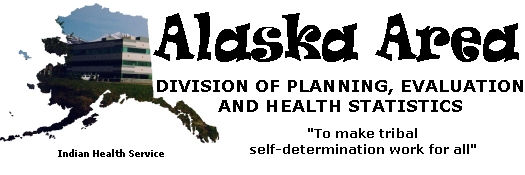| IHS Area Offices |
|
Special Reports :: Key Facts - Footnotes & Definitions1. QuickTable-P1. Age Groups and Sex: 2000. Data Set: Census 2000 Summary File 1 (SF1) 100-Percent Data. Geographic Area: United States. U.S. Census Bureau.2. QuickTable-P1. Age Groups and Sex: 2000. Data Set: Census 2000 Summary File 1 (SF1) 100-Percent Data. Geographic Area: Alaska.
3. Summary File 2, 2000 Census. State of Alaska, Department of Labor and Workforce Development, Census & Geographic Information Network.
4. Health Status in Alaska, 2000 Edition, State of Alaska, Department of Health and Social Services, Division of Public Health, Data and Evaluation Unit. January 2001.
5. Alaska Bureau of Vital Statistics, 1998 Annual Report, State of Alaska, Department of Health and Social Services, Division of Public Health, Bureau of Vital Statistics. June 2000.
6. Alaska Native Births and Infant Deaths, 1980-1997. Alaska Native Tribal Health Consortium, Alaska Area Native Health Service, Division of Planning, Evaluation, and Health Statistics. August 2001.
7. Murphy SL. Deaths: Final Data for 1998. National vital statistics reports; vol 48 no. 11. Hyattsville, Maryland: National Center for Health Statistics. 2000. 8. Three year Age-Adjusted rates for Alaska Natives are prepared from mortality tapes from the State of Alaska Department of Health and Human Services, Bureau of Vital Statistics.
9. Alaska Native Mortality, 1980-1998. Alaska Area Native Health Service, Alaska Native Tribal Health Consortium, Division of Planning, Evaluation, and Health Statistics. June 2001. 10. Regional Differences in Indian Health, 1998-99. U.S. Department of Health and Human Services, Indian health Service, Office of Public Health, Division of Community and Environmental Health, Program Statistics Team.
11. Alaska Population Overview: 1999 Estimates. State of Alaska, Department of Labor and Workforce Development, Research and Analysis Section. May 2000.
12. In Step - The Plan, 2001 - 2006: Comprehensive Integrated Mental Health Plan. State of Alaska, Department of Health and Human Services, Office of the Commissioner. November 2001.
13. Ventura SJ, Mosher WD, Curtin SC, Abma JC, Henshaw S. Trends in pregnancy rates for the United States, 1976-97: An update. National vital statistics reports; vol 49. no. 4. Hyattsville, Maryland: National Center for Health Statistics. 2001. 14. http://www.eed.state.ak.us/stats
15. Fetal Alcohol Syndrome: 2001 Status Update. State of Alaska, Department of Health and Human Services, Office of FAS. 2nd Printing, January 22, 2002. 16. Low birthweight is birth weight of less than five pounds, eight ounces or 2,500 grams. 17. Neonatal mortality rate is the number of deaths under 28 days of age per 1,000 live births. 18. Postneonatal mortality rate is the number of deaths that occur from 28 days to 365 days after birth per 1,000 live births. 19. Infant mortality is the death of children who have not reached their first birthday expressed as a rate (per 1,000 live births). 20. Life expectancy, the average number of years of life remaining to a person at a particular age, is based on a given set of age-specific death rates. 21. Age adjustment is the application of age-specific rates in a population of interest to a standardized age distribution so that differing populations can be compared. It is expressed as a rate per 100,000 population. 22. The crude death rate is the number of deaths in a year divided by the estimated population and expressed as number of deaths per 100,000 population. 23. Dependency ratios show how large a burden of support is placed on the working age population. 24. Birth rates are per 1,000 population (in the age group, if applicable).
[produced by: Alaska Native Tribal Health Consortium, Division of Information/Technology
dleach@anthc.org]
|
